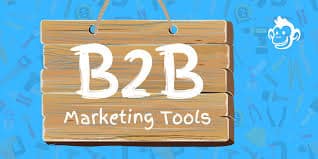It’s not easy to master the art of marketing. Marketers have many balls to juggle when establishing a marketing plan, including creative requirements, financial constraints, and channel selection. But, your target market is the single most important factor in how successful your marketing will be. Your marketing efforts will be in vain if you don’t reach out to the right people with your promotions and adverts. It’s as if you’re not trying to market at all. Nonetheless, there is significant variation between consumer audiences and commercial audiences. Companies may focus on either individual consumers or business clients. The marketing process for corporations is quite different from that of consumers. In this guide, we will discuss b2b marketing characteristics, strategies, examples, types, and the difference with b2c marketing.
What Is B2B Marketing?
Business-to-business marketing, or B2B marketing, is the practice of selling goods and services to other companies and organizations. There are some crucial differences between B2B and consumer-focused B2C marketing.
In general, business-to-business (B2B) marketing material is less flashy and more basic than consumer-facing material. This is because the bottom line is a more important factor in business buying decisions than in consumer ones. While return on investment (ROI) might not be top of mind for the average person, at least not monetarily, it is for business leaders.
Nowadays, it’s common for B2B marketers to pitch their products and services to multi-member “purchasing committees” comprised of influential individuals. This creates a difficult and delicate environment, but as data sources have become more extensive and reliable, B2B marketers’ capacity to map out committees and target buyers with relevant, individualized information has considerably increased.
Types of B2B Marketing
Before sending out a flurry of cold emails to influential people, it’s wise to have some understanding of the market you’re trying to break into. You have to find out what they want, how they like to be communicated with, and what problems keep them up at night.
Buyers of for-profit businesses might also be non-profit organizations. Here are four main types to assist you in better understanding the many sorts of business customers in B2b marketing.
#1. Producers
Manufacturers purchase goods and services from B2B vendors in order to create final products. Some manufacturers sell the finished products they have changed to other businesses. Some businesses instead want to deal exclusively with the end user, bypassing any middlemen.
McDonald’s purchases beef from a business-to-business vendor and then processes and markets the meat to consumers. Manufacturers like Procter & Gamble are also options. They source raw materials from B2B suppliers, then process those commodities into finished goods to resell to retailers.
#2. Institutions
Institutional markets consist of philanthropic groups like the American Red Cross, churches, hospitals, charities, private universities, civic clubs, and so on. They make massive purchases of goods and services, just like the government and philanthropic groups. As such, they place a premium on finding ways to reduce expenditures. When expenses are reduced, more individuals can benefit from their help.
#3. Government
Just who do you think would be the biggest buyer in the entire world? The United States federal government. It spends money on everything from paper and fax machines to tanks and armaments, buildings, NASA (National Aeronautics and Space Agency) toilets, highway construction services, medical and security services, and just about anything else you can think of. Several governmental entities, both federal and municipal, are also major purchasers. They hire private firms to handle everything from public transportation to trash pickup. (Overseas federal and state governments as well as municipal administrations.) Even for smaller stores, the Business-to-Government (B2 G) sector, which is when businesses sell to government entities like municipalities, states, and the federal government, represents a sizable revenue opportunity. In reality, many governments mandate that their departments allocate a specific percentage of contracts to small firms, minority and women-owned organizations, and veteran-owned businesses.
#4. Resellers
Businesses that act as resellers sell the products and services of others without making any significant changes. Retailers, brokers, and wholesalers all fall into this category. Two major stores that you’re probably familiar with are Walmart and Target. The market is dominated by large wholesalers, brokers, and retailers. In addition, if you can convince them to buy, you may see a meteoric rise in revenue.
What Are the Main Characteristics of B2B Marketing?
Characteristics of the business-to-business (B2B) marketing
- Negligible Demand Relative to Available Market
- Purchases on a massive scale
- It’s possible for a connection to be made between the buyer and the vendor.
- It’s simple to isolate and categorize potential clients.
- There are more people involved in the buying process.
- Methods used in the business world for making purchases with precision and intelligence.
- Costs and savings are the main concerns.
What Are B2B Marketing Strategies
Whenever you consult with any marketing professional, they will likely offer a number of different B2B marketing strategies. Often, they advise that you contact potential customers via private messages. You’ll need all the persuasion skills you can muster to convince this person that you offer the optimal option for their organization. The correct application of any one of a wide variety of B2B marketing strategies and examples, however, can yield substantial returns. You can learn more about the most popular ones in the list below.
#1. Content Marketing
All b2b clients want to learn something new and be confident in your company’s knowledge from the content you share on your website and in your emails. Providing valuable content alongside search engine optimization (SEO) is the best way to meet the requirements of your business partners.
It is for this reason that starting a business blog covering material pertinent to your line of work is a good idea. Educating and promoting your items to your customers while also providing them with useful information is a win-win.
STR Software’s approach to B2B content marketing is a model for the industry. This firm is always on the lookout for major clients with deep pockets and lengthy sales processes. STR’s “BI Publisher University” was developed by the company’s lead generation experts.
Very helpful resources for entrepreneurs may be found on this site. Furthermore, a subscription form is included on every page to gather information for lead nurturing.
#2. Social Media Marketing
SMM, or social media marketing, is a sort of digital marketing that promotes goods and services via social media websites. A whopping 84% of C-suite and VP-level buyers say social media influences their decisions.
Social media marketing (SMM) is an approach to increasing exposure to and following within a certain market or community. LinkedIn, Instagram, Facebook, and even TikTok are just some of the popular social media platforms that B2B companies employ for online marketing today.
In order to keep their Instagram followers interested and engaged, companies like MailChimp post engaging and useful content on a regular basis. A wide variety of videos, including comedic sketches and reports on current events, are available.
#3. Email Marketing
It goes without saying that emails offer a fantastic opportunity to get in touch with potential customers. Keeping in touch with business associates and updating them on developments and offers requires the use of electronic mail. In fact, studies have shown that over 93% of B2B marketing experts employ this tactic when trying to forge new partnerships.
Furthermore, consider including helpful pieces of information in your emails to give your partners a cause to start working with you. Explain how your service will benefit customers by addressing their pain points. SendPulse provides all the features needed to create polished email marketing campaigns for small organizations. 15,000 emails a month are included in the free plan.
Asana, for instance, notifies potential customers of its services via email. They present the system and demonstrate its usefulness for managing business operations. In the email, there is a call to action button that allows the prospect to initiate the project immediately.
#4. Messenger Marketing
Business-to-business (B2B) messaging marketing is thriving. Adlibweb data shows that instant message open rates are close to 80% and that click-through rates are 20%. In addition, if you are unsure about which messenger to use, the most common choice among professionals is Facebook.
It’s possible to launch a successful advertising campaign using the many features of Facebook Messenger. Simplifying interactions with prospective and current business partners can be accomplished through the use of various online tools, such as Facebook’s auto-replies and chat widgets for Messenger and the website.
#5. SMS Marketing
The open rate for this kind of message is 98%, as reported by Mobile Marketing Watch. With numbers like these, there’s no denying the efficacy of sending out text messages as part of your marketing campaign.
SendPulse allows you to send customized SMS messages to each of your customers based on factors such as their first name, gender, geography, level of interaction, and more. As part of this tactic, you might let your business associates know about sales and other activities your firm is hosting.
How to Create a B2B Marketing Strategy
There is a great deal of rivalry for consumers’ time and money. Effective B2B strategy development needs careful preparation, implementation, and oversight. For a bird’s eye view of how business-to-business organizations differentiate themselves in a competitive market, consider the following:
#1. Develop a Vision
If you don’t plan for anything, you’re planning to make that something fail. There will never be a time when this statement is not true. Choose concrete and observable goals for the company before you start cranking out adverts and content. The next step is to create or adopt a framework for your B2B marketing plan that will help you reach those goals.
#2. Concentrate on Your Niche Market
Your business-to-business offerings are designed to solve problems unique to a select group of customers. It is crucial to reach out to people who are actively seeking the products or services you provide, so it is important to narrow down your target audience as much as possible.
Developing a profile of your ideal customer is a smart move. Learn more about what your customers require and the issues they’re experiencing. To get a clearer perspective of your clientele, you might also conduct interviews with repeat consumers.
#3. Establish B2B Marketing Strategies and Platforms
After you have collected sufficient information about your intended audience, you must decide how and where you will communicate with them. The information you gathered in the prior stage should serve as a road map for this one. Consider the following questions about your ideal clients/customers and choose your answers.
- If they are online, where do they typically go?
- What kinds of things do people type into search engines?
- If they use social media, which platforms do they favor the most?
- When compared to your rivals, how are you able to fill in the gaps where opportunities exist?
- Where can you find them networking?
#4. Launch Your Ad Campaign
It’s time to go forward once you’ve finalized your plan and settled on the most effective techniques. Be sure that everyone on your staff is committed to providing excellent customer service.
It is crucial to familiarize oneself with the greatest marketing tactics and to incorporate certain recommendations into one’s plan. Likewise, keep in mind how important it is to zero down on your intended demographic. Your primary responsibility will be to craft messages that educate a targeted audience of potential business partners.
Conversational and contextually relevant content is key to the success of any b2b marketing effort. It goes without saying that your business-to-business marketing efforts should always be evolving and growing. You should always take stock of your progress and evaluate your outcomes.
#5. Control and Enhance
Always engaging in this practice will ensure that you continue on the path to success. For want of a better term, you want to discover what makes your best-performing content so successful and your worst-performing material so unsuccessful. With this knowledge, you can allocate resources more effectively. The more regularly you study analytics and put your learnings into practice, the more likely you are to achieve and even exceed your targets. Without substantial interaction and conversion statistics, content and campaign creation still involve a lot of guessing, even with a solid research base.
Follow the lead of your target demographic. Double down on the channels, subjects, and media that are resonating with your audience by consulting analytics. In the meantime, you should get rid of or change up everything that isn’t working.
What Are the Different Types of B2B Products?
Many categories of b2b products exist. Each product category is distinct, so categorizing them is useful for formulating plans. Choosing the right strategy for your business can be significantly determined by the different categories of B2B products.
The B2B market is quite diverse, thus the products sold within it can be categorized in many ways. There is no comparison to the typical organization of consumer goods into “convenience,” “specialty,” and “shopping” categories.
Products sold to other businesses are organized in a unique way: From a business-to-business perspective, products are categorized based on their end use.
In addition, there are three main categories of business-to-business (B2B) products, and the most common way to categorize them is as follows: entry-level products, core products, and support products. Now, let’s examine each one in turn:
#1. Primary Resources
Those items are crucial in the production of everything else. All necessary components and setups are included in this. The former includes things like workplaces, whereas the latter are things like machines. In contrast to inputs, such as raw materials or labor, foundation products are not incorporated into the final output. Some of the products used as a part of a building’s foundation can be considered an expense, even though the majority of the goods are considered capital.
#2. Product/Service Data Entry
Included here are goods and services that are incorporated into a larger whole. We’re talking about things like raw materials, pieces, and materials here. B2B products can range from integrated circuits to vehicle steering wheels to lumber. From an accounting point of view, purchases of products and services are typically treated as an operating expense rather than an investment.
#3. Improving the Flow of Products and Services
Products and services in this category facilitate the accomplishment of a set of goals by an organization. Therefore, they lend a hand and provide encouragement. The facilitating commodities are not included in the final product or the manufacturing process. Facilitating goods and services are typically an operating expense rather than an asset. Services like market research, cleaning materials, and photocopiers are just a few examples. Supplies and business services are the two main categories of facilitating commodities. In addition, things that are typically classified as (maintenance, repair, and operations).
What is B2B Marketing Examples
Companies in the manufacturing sector frequently deal with other businesses and have accounts with large corporations. If we take the iPhone as an example, one of Apple’s main suppliers is Samsung. Apple also has b2b partnerships with companies including Intel, Panasonic, and Micron Technology (a manufacturer of semiconductors).
Furthermore, the automotive industry relies heavily on business-to-business trade. Automobile companies buy many separately produced vehicle parts in order to put together finished vehicles. Manufacturers of tires, batteries, electronics, hoses, and door locks, among other components, typically sell their wares directly to automakers.
The service industry is not immune to business-to-business trade. Rather than marketing their services to the general public, businesses that focus on property management, housekeeping, and industrial cleanup typically only deal with other businesses.
Here are Examples of How to Do B2B Marketing
#1. B2B SEO Example
Your business-to-business (B2B) web marketing efforts will benefit greatly from SEO. Clients want to make smart purchases, therefore they turn to the internet for initial investigation. You may not even be considered a vendor if you don’t rank highly for your product or service.
If you have a business website, using content marketing to your advantage can help your search engine optimization efforts. With the help of content marketing, your brand will be seen as an expert in its field by both people and search engines. Manufacturing web design and B2B manufacturing marketing have both benefited greatly from content strategies and examples. Together, they boost manufacturers’ search engine optimization and increase their share of organic search traffic. However, by consistently releasing in-depth guides, you’ll demonstrate mastery of your field and empower your audience to make better choices.
Successful business-to-business (B2B) online marketing campaigns often combine review and content marketing methods to achieve first-page Google results. Your business will benefit from increased visibility in search engine results, and the credibility you get from positive customer feedback will attract more customers.
#2. B2B Social Media
Previously a deciding factor, social media is now a qualifying one. Just being present on social media is no longer enough to distinguish your company from the pack. Your absence from the most popular social media platforms may cause you to lose business.
To determine if your company is a good fit, business purchasing managers will look at evaluations posted on social media and take into account the company’s culture. This is especially the case for sectors that rely on innovation, such as those in search of the best marketing firms and other professional services. There is no doubt that social media marketing is essential for your company’s success, but it seems that merely being present on these platforms may no longer be enough.
Social media’s organic reach has been steadily dwindling over the past few years as the platform’s user base has been increasingly saturated. You need a social media marketing budget if you want to reach as many potential clients as possible.
#3. Marketers Should Use Automation Tools
As a B2B marketing strategy, marketing automation is on the rise in popularity. With automation, you can interact with and cultivate business leads, as well as coordinate efforts across all of your marketing platforms.
One use case for marketing automation is to send relevant, tailored emails once someone submits a form on your website to get a case study. As a result, you can make the most of each and every contact that your B2B marketing efforts bring about.
Don’t inundate your business connections with marketing automation messages. Contacts may opt out of your marketing list if you send them too many emails or if you utilize too much personalization in your messages.
#4. Determine the Sources of Discomfort for Your Clients
Finding out exactly what those consumers need is step one in effective b2b marketing. You can’t expect customers to rush to your door just because you’re selling something. Determine the reasons people want your product or service and how you may set yourself out from the competition.
Creating user groups comprised of actual customers is a good method to hone in on what those customers actually want. Customer user groups are like focus groups for a new product only they use the people who are already using and appreciating your services. To illustrate, after conducting interviews with your target audience, you may learn that cloud security is a major source of discomfort for IT clients and that this is the area you should concentrate your marketing efforts on. Tailoring your marketing message to address these problems can have a significant impact.
User groups can be held in person, or online questionnaires can be created to learn about consumers’ individual struggles. You can also use existing statistics in your sector, or conduct keyword research to find out how much interest there is in organic search.
B2B Marketing vs B2C
B2B marketing targets other businesses, while B2C marketing targets individual consumers. Both business-to-business (B2B) and business-to-consumer (B2C) marketing rely on the same underlying principles but cater to distinct target audiences through different approaches. A better business, more customers, and more money can be yours if you master each type. Here are the main difference between b2b and b2c marketing:
| B2B | B2C | |
| Communication | Makes use of domain-specific terminology and acronyms | Easily accessible information is available to the consumer base. |
| Decision-making process | In some cases, the time required to make a decision can be quite lengthy. | Customers typically don’t need a lot of lead time before making a purchase. |
| Examples | Advertising agencies, and office supply makers. | Retail outlets, motels, eating establishments, etc. |
| Target audience | Sales Channels for Competitors | Sales to end-users in the marketplace |
With b2b marketing, as you can see, your target audience consists of businesses rather than consumers. Your primary objective is to network with office managers or other high-ranking employees of the company with which you hope to do business. After all, it is their decision as to whether or not the corporation will buy your goods.
Also, keep in mind that B2C clients typically want to obtain helpful information about a service or product as soon as feasible. People today put a lot of stock in peer endorsements and online ratings when deciding which businesses to work with.
B2B marketing examples also help consumers find out more information about the items and services that they’re interested in. As soon as they become aware of the possibilities, they will begin looking for additional information about your business and comparing it to others. Moreover, they may hunt for customer reviews from other sources and products that are similar to yours offered by other companies.
Conclusion
Sales tactics are often more direct and assertive in B2B marketing. There is a high level of competition for the small pool of potential clients in the current market. That’s why they have to use heavy pressure when advertising. Establishing connections with other companies before diving into B2B marketing is a good idea.
B2B Marketing FAQs
What are the advantages of b2b marketing?
- Gets you, new clients/customers.
- Higher visibility
- Product improvement
- Increases sales
What are examples of B2B companies doing marketing?
- Google AdWords
- General Electric
- Lenovo
- DatAvail
Related Articles
- What is B2B Sales? 15 Best Strategies for B2B Sales Lead.
- Blockchain Technology Simplified!!! (+ All you Need)
- E-Commerce Explained: Types, Examples, And Advantages.
- Business-to-Business (B2B): How Does It work?
- CAC MARKETING: Meaning, Formula & How to Calculate It






